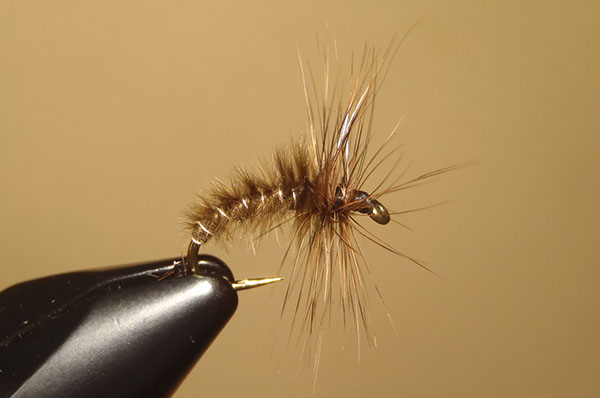The more I fish tenkara the more I’m starting to think about flies in terms of “paradigms” rather than “recipes”. Instead of specific patterns like an Oki Kebari or Takayama Kebari, I’m starting to think more in terms of the general characteristics a fly has such as movement, silhouette, attention point, and size.
One of the things that really sold me on tenkara early on was the versatility and lifelike movement of the reverse hackle sakasa kebari. After observing the opening and closing of the hackle underwater, I realized why these flies were so effective. But many insects also have gills, tails, and other appendages that move too. So instead of making only the hackle of the fly come alive while leaving a static thread body, why not animate the entire fly? That’s where maribou comes in.
We know that the movement of the hackle in a sakasa kebari is extremely attractive to trout so it would stand to reason that if the body had more of a wriggle-factor too, it would be even more enticing. Maribou is very pliable and moves easily in even the slightest currents, further convincing the trout that your fly is alive.
So in this paradigm, I’m essentially wrapping maribou for the body of the fly and counter wrapping it with wire. The fibers that peek out between the wire wraps not only add segmentation, but also pulsate (even when dead drifted). But aside from the segmentation effect and added movement, the wire is necessary since maribou isn’t very durable. If you don’t use it, a maribou-bodied fly might only last one or two fish so I recommend using a counter wrap.
Maribou is also a good body material choice since it absorbs water and will help the fly sink.
Again, this is a paradigm, not a recipe. There are endless color and material combinations you could experiment with. But just for example, here is the recipe for the fly as shown in the picture above.
Hook: Tiemco 2457
Thread: Uni 6/0, black
Body: Sculpin olive maribou, twisted into a rope and wrapped
Rib: Small, silver wire
Hackle: Brown grizzly
This design is quick and easy to tie but very buggy and effective. And with a little imagination, you can easily spend hours at the vise having fun coming up with different variations that will no doubt lead to countless hours of fun catching fish with them on the stream.









Very nice fly Jason. It has a very buggy appearance and an extra amount of realism over many other kebari that have popped up in recent years.
Comment Hello Jason,
great achievement that is mounting, I used ostrich herls in place of the marabout but it is true that I have not thought to do the whole body
Brilliant!
Yep, great idea.
“…so it would stand to reason that if the body had more of a wriggle-factor too, it would be even more enticing.”
Assuming that there is a bug endemic to those waters displaying those characteristics, and that that “look” is something programmed into a trout brain.
IMHO, the variations of trout flies are more a result of a fisherman’s imagination than a trout’s brain.
Which brings us to the question, especially when we are successful, … Is it the fly, the drift, or the depth, and which one is the most important?
And that IS a good looking fly, and I’ll soon see if the trout in my area agree.
Thanks!
Jason that is a great looking fly! I really like the “paradigm” vs. “recipe” distinction. The concept of “buggy thing that floats on the surface, buggy thing that suspends below the surface, and buggy thing that sinks to the bottom” is something I’ve been working on myself. My thought is that a fly, in the right zone, with enough general food-like attributes, should be successful across a broad range of conditions. So far the results have been encouraging. Please keep us posted on what results you see!
Hi Matt,
Yeah, it’s been working out for me. I think, “I need a dark and robust sakasa kebari for this stream”, or “I need a light and sparse fly for that stream”. I pick my fly for the day by characteristics rather than specific pattern. It actually kind of reminds me of fly selection for saltwater fly fishing. Seems to follow similar principles. Maybe I now see trout more as predators than snobby entomologists.
‘
“Maybe I now see trout more as predators than snobby entomologists”
I love that!
To my mind fishing is always ruled by fish’s stomach preferences and the selectivity level is linked to its hunger degree!
So that’s why there are days when any fly seems to work while others need specific ones.
Hi Jason !
Nice idea to use Marabo.
Can you give a short discription to make the body ?
And which product of marabu feather du you use?
Greetings from Austria
Bernhard
Hi Bernhard,
I just use a regular maribou feather, cut off the tips, tie it in by the tips, then wrap it with wire for durability. Hope that helps.
THX !
I like this fly pattern. Very nice and I’m sure effective. I’ll give it a try.
Thanks for taking the time to post.
Hi Jason, do you wet the maribou or just twist it dry?
Thanks !
Hey Marc, I just twist it dry.